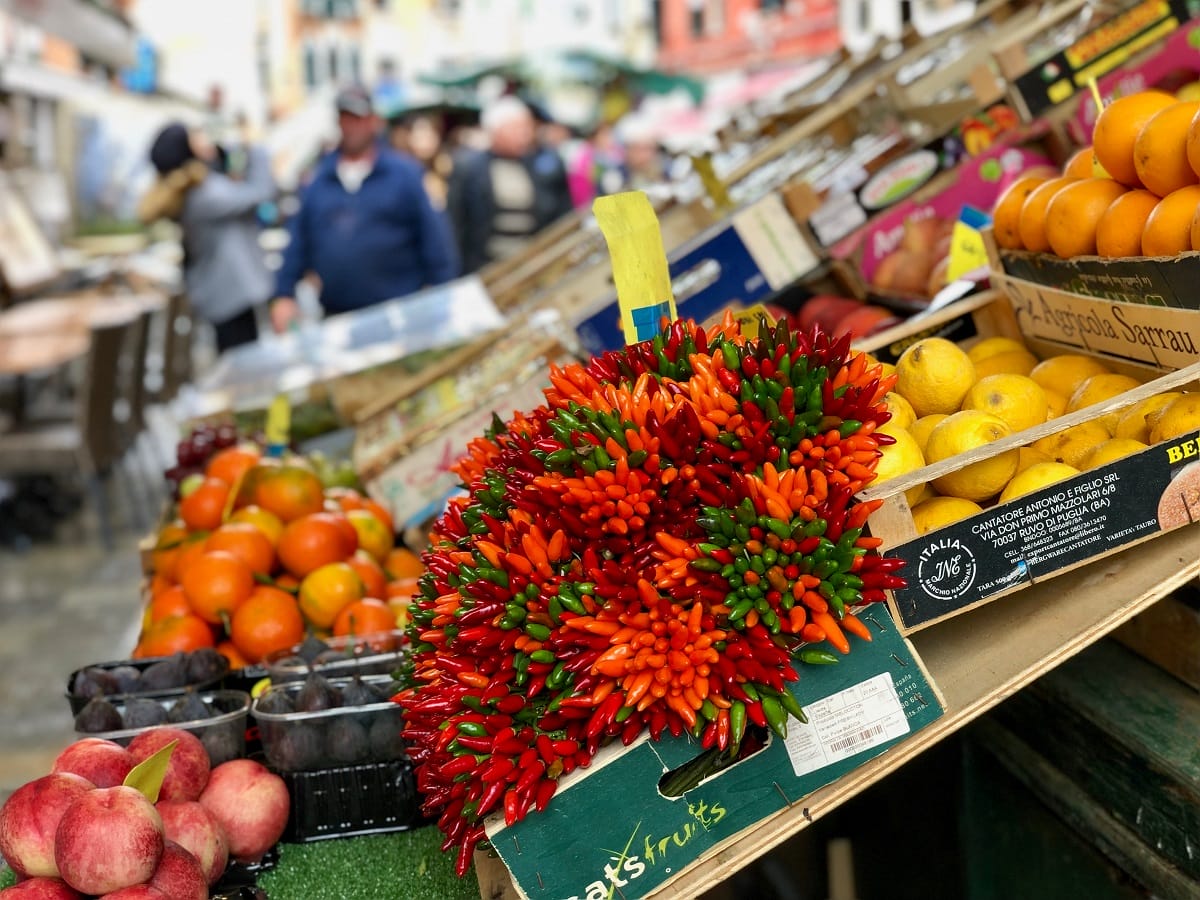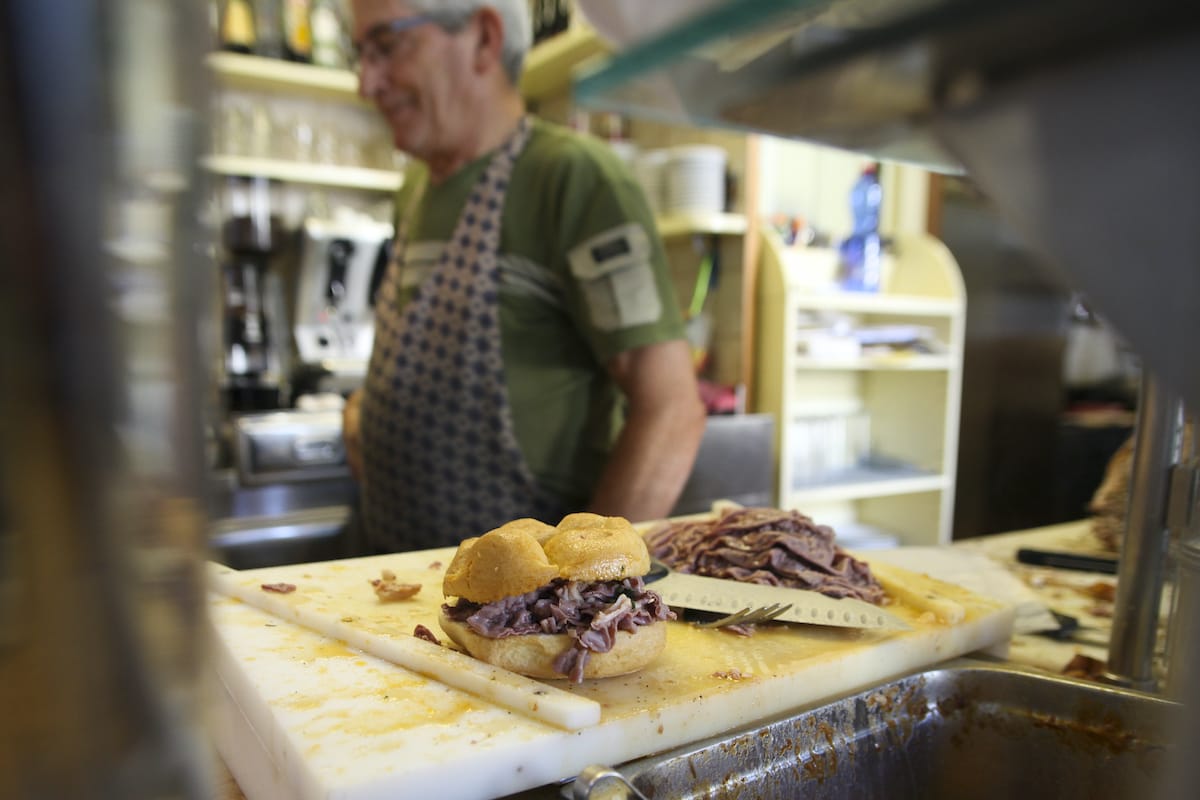
Unusual Italian Food: The Most Surprising Dishes You’ll Find in Italy
March 5, 2025
Think Italian food is just pizza and pasta? Think again! Italian dishes actually go far beyond those staples. In fact, unusual Italian food includes some ingredients that might seem downright strange to you.
Italy has a long tradition of unusual and unexpected dishes, from donkey meat to tripe. Most of the “stranger” Italian dishes were created out of necessity. By using the entire animal or buying the off-cuts, Italians throughout the centuries could save money and still eat a nutritious meal. They still refer to this type of cooking as cucina povera, or “poor cooking”. The recipes are local and come from what was readily available throughout the country’s history.

Incredible – and most likely unfamiliar – foods at a market in Italy. Photo credit: iSAW Company
Let’s explore some of Italy’s most unusual food and the cultural history behind them. Which ones would you be willing to try?
Table of Contents
ToggleHorse Meat in Italy: A Delicacy with Deep Roots
One of Italy’s most unusual foods is horse meat. Italy’s consumption of equine meat comes from its agricultural past, when the animals were used to work the fields and food was scarce. Horses and donkeys were seen as protein like anything else, and the people ate them out of necessity. The trend really grew in the 1800s when doctors prescribed equine meat to combat anemia, as the meat is high in iron and low in fat and cholesterol.
Today, the popularity of horse and donkey meat is on the decline as Italians are beginning to think of horses more as domesticated animals. That said, Italy still has the highest consumption of equine meat in all of Europe and there are still plenty of delicious dishes to be found throughout Italy. Try the donkey ragù in Verona or the stracotto d’asino, a dish made with donkey meat slow-cooked for hours and hours. Horse can be tried in a similar dish, usually served with polenta, or sliced as a cured meat.

You may not recognize all of the food you see in Italy. We break down the country’s weird and wonderful foods in this post!
Pork in Italy: From Prosciutto to Nose–to-Tail Eating
It’s no secret that Italians are big pork eaters, but a lot of unusual Italian food includes pork. In fact, some of the most famous regional dishes use some of the strangest cuts of pork. For example, Roman amatriciana pasta with guanciale, or pork cheek, the cassouela from Lombardy which uses pork snout, ears and feet.

Amatriciana pasta – with delicious guanciale – goes with just about everything!
The famous (and famously difficult to pronounce) ‘ndocca ‘ndocca from Abruzzo – a region with cold winter temperatures and a history of rural life – simply seasons the feet, ears, tail, snout, and pork rinds with bay leaves, garlic, rosemary and chili peppers.
If this is making you a bit squeamish, remember that you’ve probably eaten a lot of these things before in the form of salumi, or cured pork. Popular salumi’s include coppa di testa or soppressata, both made of pork head.
Traveler’s tip: Want to explore more traditional dishes? Check out our guide to 16 of The Most Iconic Foods to Eat in Italy. Our Guide to Seasonal Eating in Italy is also a useful resource when exploring Italy during any time of the year.
Tripe and Offal: Italy’s Love for Nose–to-Tail Cooking
When exploring unusual Italian food, perhaps the most foreign to some are tripe and organs. We’re not talking about your grandmother’s famous liver dish – the Italians go much farther than that. Regional dishes exist throughout all of Italy featuring different cow organs. Try a classic veal tongue, boiled, sliced and seasoned in Liguria or Piemonte.
Or try the ever-popular panino con la milza (pani câ meusa in the local dialect) from Palermo, Sicily. This is a sandwich filled with veal spleen and lung that’s been boiled and fried. You can ask for cheese added if you’d like.
Tripe is the white, rubbery lining of the cow’s stomach. It’s cooked in various ways, but most often put together as a hearty soup. Called trippa in Italian, this dish is typical of many Italian regions, but especially in Lombardy, Lazio and Tuscany. One particular Tuscan tripe dish is called lampredotto, with Florentine tripe eaten in sandwiches with green sauce or hot sauce (if you like the sound of that, check out our post about some of the best panino shops in Florence).

Lampredotto is the perfect panino option for adventurous eaters. Photo credit: Nicolas Mirguet
Italian Seafood Specialties: Sea Urchin and Raw Octopus
Anyone who has had sushi is used to eating raw seafood, but Japan isn’t the only country with a culture of raw fish in its cuisine. Down south in Puglia, the consumption of local seafood is so widespread, that the government enforces no-fishing periods to help repopulate the waters. For the Pugliese, the best way to eat all that fresh seafood is to eat it right away!
The most popular raw seafood dish, and easily one of Italy’s most unusual foods, is the sea urchin. Inside that hard, spiny exterior is a delicious orange organ that is actually…wait for it…the sea urchin’s gonads. Second only to the sea urchin is raw octopus. Considered a specialty, the fishermen follow a precise procedure to clean the octopus. They remove its internal organs, pound it against a rock to tenderize it, and stir it for an hour to cause the tentacles to curl, relaxing the nerves and making the octopus meat extra tender. This specific dish is called pulpe rizz, or octopus curl.
Foraged Foods in Italy: Edible Weeds and Unique Ingredients
Despite what the list implies, Italians eat many, many vegetables and they’re quite fanciful in their preparation. Some of the odder vegetable choices include cicoria, or dandelion leaves.
A weed in most countries, Italians cook it in any which way to make a unique side dish. Another favorite is pumpkin flowers, or fiori di zucca. Italians use these pumpkin or zucchini flowers to make a flavorful risotto or fry them up with anchovies and mozzarella cheese.
Unusual Italian Food FAQ
What are some unusual Italian foods?
Italy is known for its rich culinary traditions, but some regional dishes surprise even adventurous eaters. These include donkey meat, tripe, lampredotto (cow stomach), and bottarga (cured fish roe).
Do Italians eat donkey meat?
Yes, Italians eat donkey meat, especially in regions like Veneto and Puglia. It is often slow-cooked to bring out its rich flavors.
What is tripe, and how is it eaten in Italy?
Tripe is the edible lining of a cow’s stomach. In Italy, it is often prepared in tomato sauce (trippa alla romana) or served with beans.
What is the strangest dish in Italian cuisine?
Some might consider lampredotto, a slow-cooked cow stomach sandwich from Florence, to be one of the most unusual Italian dishes.

Lampredotto is one of the best, most authentic ways to eat on the run in Florence.
What is the best wine to pair with unusual Italian cuisine?
The good news is that no matter what traditional or unusual Italian dish you are enjoying, there is a fabulous wine that will go well with it. For more details on trying Italian wines, check out our guide on How to Enjoy the Best Italian Wines in Rome, Venice, and Florence.
Update notice: This article was updated on March 5, 2025.
Enjoy learning about a country through its food? Join one of our food tours in Bologna, Florence, Rome, Naples, or Venice! You’ll gain a new understanding of each city’s cuisine – and try the best bites around – with a passionate local guide. We hope to see you on your next trip to Italy!

by Gina Mussio
View more by Gina ›Book a Tour

Pristine Sistine - The Chapel at its Best
€89
1794 reviews

Premium Colosseum Tour with Roman Forum Palatine Hill
€56
850 reviews

Pasta-Making Class: Cook, Dine Drink Wine with a Local Chef
€64
121 reviews

Crypts, Bones Catacombs: Underground Tour of Rome
€69
401 reviews

VIP Doge's Palace Secret Passages Tour
€79
18 reviews

Legendary Venice: St. Mark's Basilica, Terrace Doge's Palace
€69
286 reviews










